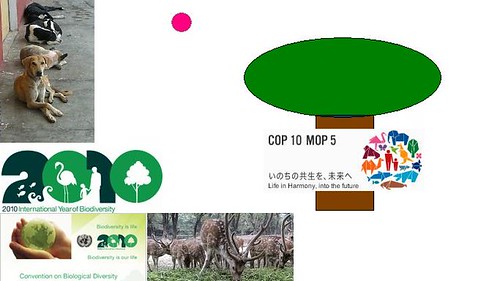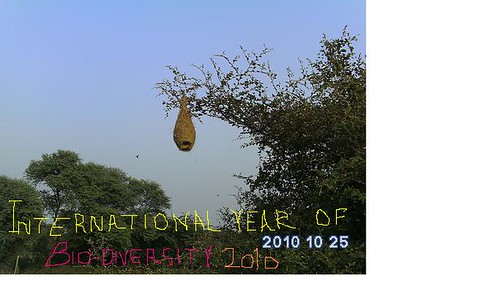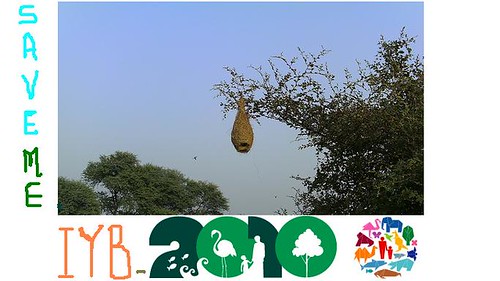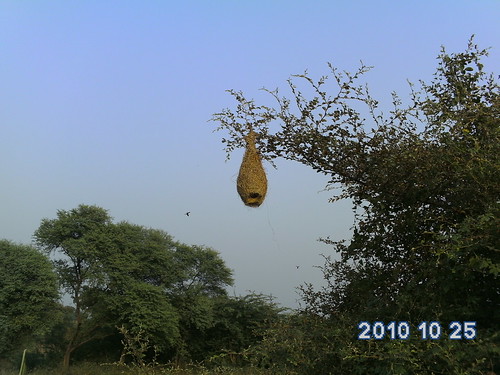The anticancer drug, called maytansine inhibit proliferation of breast cancer cells at mitosis. The Maytansine and its analogues maytansinoids are extraordinarily potent antitumor agents that were originally isolated from members of the higher plant families Celastraceae, Rhamnaceae, and Euphorbiaceae. The maytansinoids, a group of ansa macrocyclic lactams with potent antitumor activity, were first isolated from Maytanus species of family Celastraceae. This reasearch will open the new hope for breast cancer disease treatment.
[Source: science360.gov]
This blog is for the followers of RED TAPE MOVEMENT. This movement is running for the saving of the existing trees by binding red tape on tree stem.
Wednesday, November 10, 2010
Tuesday, November 9, 2010
Tuesday, November 2, 2010
Backyard Wetland
Build a wetland in your backyard. Learn how by visiting the U.S. Department of Agriculture’s web site.
Monday, November 1, 2010
Wetlands and Sarsai Nawar Wetland
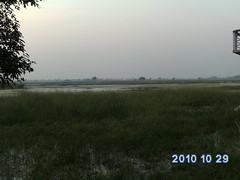

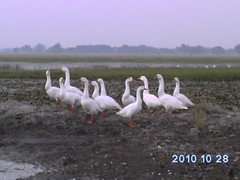
![Growers of Water Caltrop [Trapa natans], Singhara, in wetland area, Sarsai Nawar](http://farm2.static.flickr.com/1260/5129058668_a900f9cde5_m.jpg)
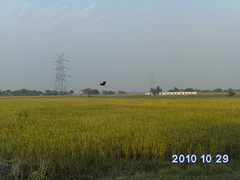
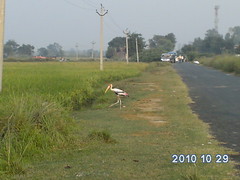
The Ramsar Convention (Article 1.1) defined wetlands as: “areas of marsh, fen, peat land, or water, whether natural or artificial, permanent or temporary, with water that is static or flowing, fresh, brackish or salt, including areas of marine water the depth of which at low tide doesn’t exceed six meters”. In addition, the convention (Article 2.1) provides that wetlands: “may incorporate riparian and coastal zones adjacent to the wetlands, and islands or bodies of marine water deeper than six meters at low tide lying within the wetlands. Wetlands are among the most productive ecosystems in the world, comparable to rain forests and coral reefs. In wetland ecosystem water is the primary factor controlling both the plant and animal life; they are found on every continent except Antarctica and from the tundra to the tropics . Wetlands fall into four general categories—marshes, swamps, bogs, and fens. Marshes are wetlands dominated by soft-stemmed vegetation, while swamps have mostly woody plants. Bogs are freshwater wetlands, often formed in old glacial lakes, characterized by spongy peat deposits, evergreen trees and shrubs, and a floor covered by a thick carpet of sphagnum moss. Fens are fresh water peat-forming wetlands covered mostly by grasses, sedges, reeds, and wild flowers. Wetlands favours particular type of trees, shrubby species and associated herbs and grasses with algae. Typical characteristic species of wetland ecosystem include hydrophytes such as Cyperus, Azolla, Nymphaea, Typha, Potamogoton, Wolffia, Phragmites, Eichhornia etc., and tree species include species of Ficus, Tamarindus indica, Mimusops, Syzygium, Terminalia, Acacia, Mangifera. An immense variety of species of insects, amphibians, reptiles, birds, fish, and mammals forms fauna of wetlands. Some birds, for example, Plover, Goose, Crane, Flamingo like feed and breeds in wetlands. Detritus Food Chain is the important part of wetland ecosystems. Due to typical functions like- wildlife habitat and food chain support, groundwater recharge, water purification, nutrient retention and flood control- wetlands are considered as "biological supermarkets", "nurseries of life" and "the kidneys of the landscape" (Barbier et al. 1997; Mitsch and Gosselink 1993). India is very rich in wetland habitats; Wetlands in India (excluding rivers), account for 18.4% of the country’s geographic area, of which 70% is under paddy cultivation; there are 21 "Ramsar sites in India".
Under the National Wetlands Conservation Programme (NWCP) programme, 115 wetlands (Annexure I) have been identified till now by the Ministry of Environment(India) and SARSAI NAWAR (area 161.27 ha.) is part of this and is listed at serial number 101. Sarsai Nawar is a vast and beautiful wetland (it is an open form of fen) situated in Takha block of District Etawah. In India, wetlands are disappearing at a rate of 2% to 3% every year and Sarsai Nawar wetland is also facing threats for existence; major threats are- anthropogenic activities, agriculture activities, deforestation, pesticides pollution, rural sewage pollution, introduced species threats due to Eichhornia etc. Trapa and Eichhornia have adverse impact on aquatic ecosystems. Conservation of this wetland is must for the survival of Sarus Cranes (Grus antigone) and many migratory birds as this wetland is the important part of their life and is must for their survival. Migrating birds use wetlands to rest and feed during their cross-continental journeys and as nesting sites when they are at home. As a result, wetland loss has a serious impact on these species.
Also listen about wetlands by just click here.
Wednesday, October 27, 2010
Tuesday, October 26, 2010
Monday, October 25, 2010
Saturday, October 23, 2010
Plants play larger role than thought in cleaning up air pollution

Plants play larger role than thought in cleaning up air pollution . The uptake of oVOC's was especially rapid in dense forests and most evident near the tops of forest canopies, which accounted for as much as 97 percent of the oVOC uptake that was observed. [Source: Eurek Alert, National Science Foundation and Refdoc.fr]
Thursday, October 21, 2010
Friday, October 15, 2010
Water Footprint

 [Fig: Average national water footprint per capita (m3/cap/yr). Green means that the nations's water footprint is equal to or smaller than the global average. Countries with red have a water footprint beyond the global average. Period: 1997-2001]
[Fig: Average national water footprint per capita (m3/cap/yr). Green means that the nations's water footprint is equal to or smaller than the global average. Countries with red have a water footprint beyond the global average. Period: 1997-2001]The water footprint is an indicator of water use and is defined as the total volume of freshwater that is used to produce the goods and services consumed by the individual or community or produced by the business. Human impacts on freshwater systems can ultimately be linked to human consumption. Professor Arjen Y. Hoekstra is the creator of the water footprint concept. he mission of the Water Footprint Network is to promote the transition towards sustainable, fair and efficient use of fresh water resources worldwide. Many countries have significantly externalised their water footprint, importing water-intensive goods from elsewhere. This puts pressure on the water resources in the exporting regions, where too often mechanisms for wise water governance and conservation are lacking. Not only governments acknowledge their role in achieving a better management of water resources, also businesses and public-service organisations increasingly recognize their role in the interplay of actors involved in water use and management. Based on the top-down approach, the global average water footprint is found to be 1240 m3/yr/cap. There are large differences between countries. In the USA the average water footprint is 2500 m3/cap/yr. In China the average water footprint is 700 m3/cap/yr.
So, Save Water, Save Future. Support Blog Action Day 2010 on Water. [Source of image, graph and video: Water Footprint]
Clean Water- A Big Challenge

Since the advent of INDUSTRIAL REVOLUTION, the problem of CLEAN WATER and RELATED PROBLEMS get worsten. Unplanned URBANIZATION-cum-INDUSTRIALIZATION along with POPULATION EXPLOSION resulting into WATER POLLUTION, KILLING OF WATER BODIES, DEATHS OF AQUATIC FLORA and FAUNA, UNINHABITABLE RIVERS, DEATHS OF CHILDREN due to UNSAFE DRINKING WATER etc. Today, nearly ONE BILLION PEOPLE lack basic access to safe water. The problem of UNSAFE WATER is a MAN-MADE PROBLEM; so the solution must be developed by man. SAFE DRINKING WATER is the part of Millennium Development Goal under Target 7C ; the target under MDG 7C is- Halve, by 2015, the proportion of the population without sustainable access to safe drinking water and basic sanitation. On 28 July 2010, UN General Assembly declares access to clean water and sanitation as a human right.
We are facing a big problem of clean water in 21st Century; WE CAN BRING A MAJOR POSITIVE CHANGE by living ENVIRONMENT FRIENDLY LIFE. New Urbanization and Industrialization must fulfill all the parameters of ENVIRONMENT AND WATER BODIES [ underground water, rivers, lakes, wetlands, oceans and glaciers] PROTECTION LAWS and ACTS; old cities and industries must adopt new technologies and infrastructure to treat sewage and pollutants and recycle these; there must be complete ban on release of sewage and industrial influents into water bodies. ENVIRONMENT FRIENDLY LIFESTYLE and FAMILY PLANNING must be made a compulsory fundamental duty for every citizen. Blog Action Day 2010 has announced this year's topic as WATER, at the right time. Clean and Safe water is must for humans and other living beings survival and their right too; OUR FUTURE IS IN CLEAN WATER. Be helpful in achieving MDG target 7C and secure a bright future.
Thursday, October 14, 2010
e-mail From Blog Action Day 2010

Hello Prabhat Misra,
Thanks for joining Blog Action Day! Now that you've registered it's a pretty simple process. All you need to do is put up a post relating to the topic of water on October15th and link to blogactionday.change.org somewhere in your post.
Wednesday, October 13, 2010
Tuesday, October 12, 2010
Campaign to save trees on 10-10-10

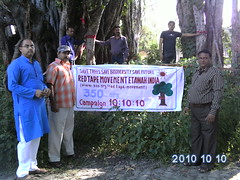
People in Etawah participated in `mission green 10:10:10 campaign' and tied red tapes on tree trunks across the district on Sunday- Times News Network. . Red Tape Movement was started by me in Etawah on 5th June, 2008. Protection of trees and biodiversity conservation are the main activities of this movement. This movement has now crossed border and reaches to Perth, Australia where one Facebook friend Ilona Slany McGavock, a human Doctor, started this with full zeal and enthusiasm on 10-10-10. Thanks to times news network for coverage and all the participants.
Sunday, October 10, 2010
Successful Red Tape Movement- thanks to all




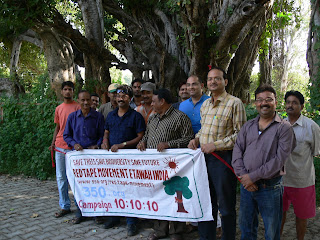
Today, is a great day when whole world is seriously thinking about how to cut carbon emissions by 10% in the year 2010. Today is Global Work Party and 10:10:10 Campaign. I also participated in this through RED TAPE MOVEMENT which was organized at District Hospital Road and in Company Garden in Etawah. Photos of the movement can be seen at Flickr. In Australia the same movement has been organized by Ms. Ilona Slany McGavock; personal thanks and Appreciation to you Ilona and Rosie[ your daughter]. I am thanking to all my Facebook friends who supported my Group and Cause, "Red Tape Movement", as well as to those who supported me on 350.org. I thanks and appreciate to Dr. Rajeev Chauhan [ Secretary General, Society for Conservation of Nature, Etawah ] and Mr. Sanjay Saxena [ President, Swami Vivekanand Sewa Sansthan, Etawah ] for supporting me and making the event successful. I am also thankful to Dr. Ajai Mishra [Vikas Udhyog Samiti], Mr. Vivek Ranjan Gupta, Mr. Nirmal Singh, Mr. Anil Singh, Mr. Vineet Chauhan, Mr. Dharam Pal Chauhan, Mr. Ashutosh Dixit and Md. Altaf for their support. Most important, i am personally thankful to my Chief Guest Mr. Anwar Warsi, District Youth Coordinator, Nehru Yuva Kendra, Etawah. Photos from Australia are on Facebook.
Red Tape Movement, 10:10:10 Campaign, Global Work Party and 350.org

The Red Tape Movement will tie red tape on tree trunks across the Etawah city and will send out a message about the importance of trees. We will also pledge to promote afforestation and adapt an eco-friendly green life. The main theme of RED TAPE MOVEMENT for "10:10:10 campaign" will be, "SAVE TREES, SAVE BIODIVERSITY, SAVE FUTURE". Respected friends, participate in this movement and help to cut carbon emissions by 10% in 2010 COZ TREES ARE BIGGEST NATURAL SINK OF CARBON DI-OXIDE. On this special day we will give the message that to cut tree is dangerous for the survival of living beings on Earth; our ONE-MINUTE care of a tree will be helpful to save lives of many; SO SAVE TREES and SAVE YOUR FUTURE. So, kindly participate in this by tying RED-TAPE on a tree trunk and take oath to protect trees, ON Sunday 10, Oct, 2010 at your residential place at 10.00 A.M. [ according to your country time zone ]. This movement is going to be supported by Dr. Rajeev Chauhan and Mr. Sanjay Saxena [Press Reporter], both from Etawah, Dr. Manoj Dixit from Manpuri and Ms. Ilona Slany McGavock from Perth, Australia. All friends are welcome to join this.
Red Tape Movement in Australia
Dear friends, one facebook friend, named Ilona Slany McGavock is organizing the RED TAPE MOVEMENT at Carawatha Primary School Site Lot 300 (10) Archibald Street, Willagee Perth, WA, 6156 Australia at 2pm on Sunday 10/10/10 to red tape the two hundred trees. Thanks Ilona for your support to my movement.
Tuesday, October 5, 2010
Putting Solar on the White House- Big Win for 350.org

Just in time to give the Global Work Party a White House-sized boost, the Obama administration announced this morning that they are going to put solar panels on the First Family's living quarters, returning to a tradition begun by president Jimmy Carter and abandoned by Ronald Reagan. This is a BIG win for 350.org. [ Source of image- 350.org ]
Monday, October 4, 2010
How to Get Working in Your Community for 10/10/10


This is the part of the original article- How to Get Working in Your Community for 10/10/10 by Jess Leber to promote 10/10/10 campaign- "This is shaping up to be huge. According to 350.org's web site, there are right now 5,479 events planned in 176 countries for the big day (only 14 countries are missing!).
So as the big day finally approaches a week from this Sunday, I wanted to give you an update and provide some tips about how to find a good event, and also how to organize your own. It's definitely not too late.
First: You can check out 350.org's map of events to see if there is a cool one already organized near where you live (there are more than 1,000 in the United States alone). Personally, I'm going to the Washington, D.C. festivities where I live, which include a big rally at the White House, a community garden fall harvest, and a promotional ride to publicize my city's new bikeshare program.
Second: If there's nothing near you yet, you can register your own event, and check out this guide for how to organize and promote it. With a week of planning, some totally doable ideas include community gardening, bicycle repair workshops or bike lane painting, trash cleanup days, light bulb swap-outs, among other ideas discussed here". [ Source of images- change.org and 350.org]
Thursday, September 30, 2010
Plants under pressure - a global assessment
Kew, together with the Natural History Museum, London and the International Union for Conservation of Nature (IUCN) has completed a global analysis of extinction risk for the world's plants.
The project, entitled Sampled Red List Index for Plants, provides a major baseline for plant conservation and is the first time that the true extent of the threat to the world's estimated 380,000 plants is known.
The project, entitled Sampled Red List Index for Plants, provides a major baseline for plant conservation and is the first time that the true extent of the threat to the world's estimated 380,000 plants is known.
Friday, September 3, 2010
Sunday, August 29, 2010
Red Tape Movement


Today i participated in RED TAPE MOVEMENT at Etawah with the members of a local N.G.O. Swami Vivekanand Sewa Sansthan. We choosen a road-side near bungalow of Additional Superintendent of Police and tied red tape on tree-trunks and taken oath that we will SAVE TREES and BIODIVERSITY. Many local people also participated. This movement is gaining the support of local people. UNO declared year 2010 as International Year of Biodiversity and year 2011 as International Year of Forests; so such types of movements can play a good role to aware the society about NATURE and it's ECOSYSTEM.
Wednesday, August 25, 2010
Red Tape Movement on rainy Sunday
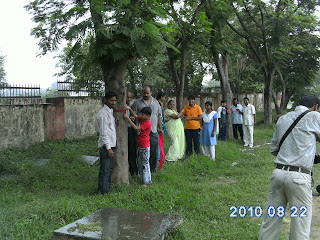
पर्यावरण की रक्षा को वृक्षौं पर लाल फीते बांधे
Story Update : Monday, August 23, 2010 12:01 AM
इटावा। स्वामी विवेकानंद सेवा संस्थान इटावा ने वृक्षौं में लाल फीते बांधकर पर्यावरण बचाने के लिए वृक्ष बचाने का आह्वान किया। इस द्रान स्पौर्ट स्टेडियम व उसके पास सड़क पर लगे वृक्षौं में लाल फीते बांधे गए।
सहायक निदेशक बचत प्रभात मिश्रा ने कहा कि जब वृक्ष बचेंगे तभी धरती बचेगी और तभी धरती पर प्राणियौं का जीवन बचेगा। लाल फीता अभियान का उद्देश्य भी वृक्ष बचाना और लौगौं कौ पर्यावरण के प्रति जागरूक करना है। ग्लौबल वार्मिंग का खतरा भी वृक्ष बचाने से टलेगा।
संस्थान के अध्यक्ष संजय सक्सेना ने कहा कि वन क्षेत्र लगातार घटता जा रहा है। इसके चलते प्राकृतिक आपदाएं आ रही हैं। हमें पहले से लगे वृक्षौं कौ बचाना है और नए प्धे भी लगाना है। लेखाकार सुनील सक्सेना ने कहा कि युवाओं कौ पर्यावरण के प्रति जागरूक हौकर वृक्ष लगाने चाहिए तथा पहले से लगे वृक्षौं कौ बचाएं। सचिव विवेक रंजन गुप्ता ने कहा कि जिस प्रदूषण से बचने के लिए मशीनौं पर लाखौं रुपया खर्च हौता है वह कार्य वृक्ष निशुल्क करते हैं। संयौजक डा. आशीष दीक्षित ने कहा कि एक वृक्ष से जितनी आक्सीजन मिलती है उतनी तैयार करने में लाखौं खर्च हौते हैं। संचालन शिवमंगल सिंह ने किया। कार्यक्रम में ओमरतन कश्यप, सर्वेश कुमार, तनुज रंजन, संजीव कुमार, अभिजीत, मयंक सक्सैना, आशुतौष कुमार, अनूप, प्रदीप गुप्ता, राजीव गुप्ता आदि मौजूद रहे।
Saturday, August 14, 2010
International Year of Forests, 2011


Forests are vital to the survival and well being of people everywhere, all 7 billion of us. Deforestation, industrialization-cum-urbanization and increasing population is reducing the forests area which is resulting into degradation of biodiversity and climate change. In its resolution 61/193 of 20 December 2006, the UN General Assembly proclaimed 2011 as the International Year of Forests to raise awareness at all levels to strengthen the sustainable management, conservation and sustainable development of all types of forests for the benefit of current and future generations. The International Year of Forests 2011 offers a unique opportunity to raise public awareness of the challenges facing many of the world’s forests and the people who depend on them. The Ramsar Convention selected wetlands and forests as the theme for World Wetlands Day 2011 (WWD 2011) in recognition of the International Year of Forests. The International Year of Forests 2011 logo is designed to convey the theme of “Forests for People” celebrating the central role of people in the sustainable management, conservation and sustainable development of our world’s forests. The Official launch of the Year will take place at United Nations Headquarters during ninth session of the United Nations Forum on Forests (2- 3 February 2011). So, SAVE FORESTS, SAVE FUTURE.
Sunday, August 8, 2010
Red Tape Movement

Today, we participated in RED TAPE MOVEMENT. This movement is the peaceful people participation awareness programme run by me with the help of local people and NGO's in Etawah. Through this, we give the message that to cut trees is lethal to our survival. Nobel Laureate and Leader of Green Belt Movement Madam Wangari Maathai said,"We have a responsibility to protect the rights of generations, of all species, that cannot speak for themselves today. The global challenge of climate change requires that we ask no less of our leaders, or ourselves.” So friends, you also participate in this mission at your home place and send your reply too. Thanks.
Wednesday, August 4, 2010
Save Forests

Forests and planktons give us the LIFE by providing OXYGEN, FOOD, FRUITS,
MEDICINES, SHELTER as well as BIODIVERSITY and sinking CARBON DI-OXIDE through PHOTOSYNTHESIS. We are now facing the lethal problem of CLIMATE CHANGE; only forests and planktons can save us from this problem coz photosynthesis occurs only in them. Launch grass-root-level awareness programmes, movements and missions to save trees and biodiversity; one such awareness programme has been launched by me and the name of this is RED TAPE MOVEMENT. Save trees for the safety of YOUR FUTURE.
Friday, July 23, 2010
NASA - First-of-its-Kind Map Depicts Global Forest Heights
Using NASA satellite data, scientists have produced a first-of-its kind map that details the height of the world’s forests. Although there are other local- and regional-scale forest canopy maps, the new map is the first that spans the entire globe based on one uniform method.
NASA - First-of-its-Kind Map Depicts Global Forest Heights
NASA - First-of-its-Kind Map Depicts Global Forest Heights
Wednesday, June 30, 2010
Human impact on Himalaya: a case study.





Recently i visited Haridwar, Rishikesh and Masoori [ Uttarakhand, India ] from 12th June to 15th June, 2010. I felt two major destructive impact of humans on hills; these are: 1. unmanageable urbanization, 2. deforestation; the other related problems due to tourism are: 1. air pollution, 2. water pollution, 3. noice pollution, and 4. polythene pollution. I get surprised to see the deforested hills and polythene pollution in Haridwar. There must be immediate ban on the use of polythene bags in the hilly regions and tourist places on the banks of rivers. Another important thing was existence of perennial herbs and woody shrubs as dominant flora; there was lesser presence of trees as dominant flora. So, this is our duty to save forests and biodiversity. Grass root level conservation programmes like RED TAPE MOVEMENT can make aware the society. Come and join hands to save forests and to save our future and our survival.
Monday, April 5, 2010
Wednesday, March 24, 2010
Subscribe to:
Posts (Atom)

